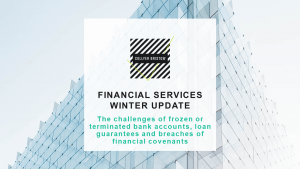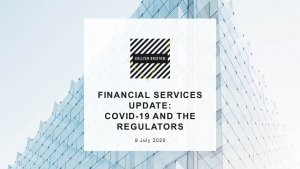- Banking & financial disputes

Longer Reads
The collapse of FTX – A regulatory and claims perspective
Partners Nigel Brahams, David Vaughan and Robin Henry share their views on the collapse of the world’s second largest crypto exchange.
3 minute read
Published 22 November 2022
Key information
- Specialisms
- Business
- Services
- Banking & financial disputes
Cryptoassets are traded on a global basis. Indeed, the markets are even more global and constant than markets in more conventional financial instruments, rivalled only perhaps by the FX markets in their reach.
The FTX collapse is the largest in the short but fast-moving history of the crypto markets and impacting investors globally at all levels. Undoubtedly, over the next few years, FTX’s creditors will explore avenues to recover their very significant losses. FTX’s new CEO, leading insolvency and restructuring lawyer, John J. Ray III has committed to maximise the recoveries for FTX customers and investigate claims against its founders, including Sam Bankman-Fried. As FTX and its creditors seek to recover vast sums of money, these are the most immediate options. FTX stated in its court papers last week said it has about 100,000 creditors and $10bn-$50bn of assets and liabilities.
Clawback
It is alleged in court papers filed in Delaware, US, that just days before the insolvency of FTX, customers and insiders withdrew billions of US Dollars in assets. Indeed, this was also confirmed by FTX’s founder, Sam Bankman-Fried, who said that approximately $5 billion of withdrawals were made on 6 November 2022, just 5 days before the Chapter 11 administration (insolvency) filing.
This opens the door to creditors’ and the insolvency practitioner (IP)’s claims to seek to claw back the $5 billions of dollars in assets that customers and insiders withdrew before the crypto company’s abrupt administration.
In order to recover assets, the IP will also investigate claims against directors for transferring assets out the company.
Preference claims
It is also reported that just before the administration, a select few creditors were paid. The IP may look at these payments as a ‘preference’ and seek to set aside the preference transactions. Additionally, they could try to claw back payments apparently made after the administration but without the court’s permission.
Lawyers for the FTX told the Court that they have “credible evidence” that the Bahamian government “is responsible for directing unauthorised access to the Debtors’ systems for the purpose of obtaining” FTX’s digital assets” after the Chapter 11 filings was made. There’s been at least $372 million of “unauthorised transfers”. If this is right, then any transfers of those assets could be clawed back.
They will also look at whether there were any transfers of assets and property designed to defraud creditors or made without receiving consideration, known as fraudulent transfers.
However, this may take some time as before these claims may be pursued, the IP and their team will need to get a handle on FTX’s finances and transactions. From the statements made by FTX’s new CEO, John J. Ray III, it is apparent that FTX’s existing financial data and documentation is inaccurate. He is reported as saying that he has never “seen such a complete failure of corporate controls and such a complete absence of trustworthy financial information as occurred here”.
Other claims
As matters evolve and the picture becomes clearer, investors will may also wish to explore other causes of action including claims against auditors by those relying on audits of FTX companies, actions by investors and traders against investment advisers who negligently recommended using FTX, claims by investors against funds which provided crypto assets to FTX without adequate due diligence and perhaps most interestingly, claims against celebrity promoters of FTX crypto products!
Comparison with Lehman Brothers
There are natural comparisons with the collapse of Lehman Brothers in 2008, an event which dominated the credit crunch and which cast a shadow over the financial landscape for many years. However, Lehman was a business regulated globally by all the leading financial regulators. Moreover, Lehman Brothers operated under a legal and corporate governance structure which was designed to protect assets in the event of insolvency. Indeed, it turned out that Lehman was so well capitalised and had such strong records that all its creditors were paid out in full.
By contrast, incoming CEO John Ray III has commented of FTX that he “had never seen such a complete failure of corporate controls”. And this is from someone who oversaw the liquidation of Enron. Creditors are out of pocket to the tune of US$ billions and unlike Lehman, they will do well to recover even a percentage of their assets or money.
Turning Points – Signs of Hope?
It is nonetheless possible, perhaps even hopeful to conclude that FTX’s collapse will be a watershed moment which will lead to crypto exchanges and businesses being operated to the standard of regulated firms. This would require co-ordinated efforts and the attention of governments and regulators across the G20 and beyond at a time when they are dealing with an intimidating list of global financial and political challenges.
Even so whilst the price of BTC has fallen significantly on the news of FTX’s demise, it has not collapsed completely, indicating that investors retain faith in the fundamental concepts behind digital assets, crypto currencies and blockchains.
With better co-ordinated regulation, we can still hope for a more stable and optimistic future for the sector. The dotcom boom and bust did not destroy the internet and web based businesses. If anything, it led to greater rigour and better legal and regulatory structures which have contributed to its ongoing and unparalleled success. We live in hope that the same can be said of the world of crypto exchanges and digital assets. The technology and advances which they offer to business and the world in general are too good to squander.
For more information, visit our Financial Regulatory page.
This article was first published on FT Adviser in November 2022.
Related content
Longer Reads
The collapse of FTX – A regulatory and claims perspective
Partners Nigel Brahams, David Vaughan and Robin Henry share their views on the collapse of the world’s second largest crypto exchange.
Published 22 November 2022
Associated sectors / services
Authors
Cryptoassets are traded on a global basis. Indeed, the markets are even more global and constant than markets in more conventional financial instruments, rivalled only perhaps by the FX markets in their reach.
The FTX collapse is the largest in the short but fast-moving history of the crypto markets and impacting investors globally at all levels. Undoubtedly, over the next few years, FTX’s creditors will explore avenues to recover their very significant losses. FTX’s new CEO, leading insolvency and restructuring lawyer, John J. Ray III has committed to maximise the recoveries for FTX customers and investigate claims against its founders, including Sam Bankman-Fried. As FTX and its creditors seek to recover vast sums of money, these are the most immediate options. FTX stated in its court papers last week said it has about 100,000 creditors and $10bn-$50bn of assets and liabilities.
Clawback
It is alleged in court papers filed in Delaware, US, that just days before the insolvency of FTX, customers and insiders withdrew billions of US Dollars in assets. Indeed, this was also confirmed by FTX’s founder, Sam Bankman-Fried, who said that approximately $5 billion of withdrawals were made on 6 November 2022, just 5 days before the Chapter 11 administration (insolvency) filing.
This opens the door to creditors’ and the insolvency practitioner (IP)’s claims to seek to claw back the $5 billions of dollars in assets that customers and insiders withdrew before the crypto company’s abrupt administration.
In order to recover assets, the IP will also investigate claims against directors for transferring assets out the company.
Preference claims
It is also reported that just before the administration, a select few creditors were paid. The IP may look at these payments as a ‘preference’ and seek to set aside the preference transactions. Additionally, they could try to claw back payments apparently made after the administration but without the court’s permission.
Lawyers for the FTX told the Court that they have “credible evidence” that the Bahamian government “is responsible for directing unauthorised access to the Debtors’ systems for the purpose of obtaining” FTX’s digital assets” after the Chapter 11 filings was made. There’s been at least $372 million of “unauthorised transfers”. If this is right, then any transfers of those assets could be clawed back.
They will also look at whether there were any transfers of assets and property designed to defraud creditors or made without receiving consideration, known as fraudulent transfers.
However, this may take some time as before these claims may be pursued, the IP and their team will need to get a handle on FTX’s finances and transactions. From the statements made by FTX’s new CEO, John J. Ray III, it is apparent that FTX’s existing financial data and documentation is inaccurate. He is reported as saying that he has never “seen such a complete failure of corporate controls and such a complete absence of trustworthy financial information as occurred here”.
Other claims
As matters evolve and the picture becomes clearer, investors will may also wish to explore other causes of action including claims against auditors by those relying on audits of FTX companies, actions by investors and traders against investment advisers who negligently recommended using FTX, claims by investors against funds which provided crypto assets to FTX without adequate due diligence and perhaps most interestingly, claims against celebrity promoters of FTX crypto products!
Comparison with Lehman Brothers
There are natural comparisons with the collapse of Lehman Brothers in 2008, an event which dominated the credit crunch and which cast a shadow over the financial landscape for many years. However, Lehman was a business regulated globally by all the leading financial regulators. Moreover, Lehman Brothers operated under a legal and corporate governance structure which was designed to protect assets in the event of insolvency. Indeed, it turned out that Lehman was so well capitalised and had such strong records that all its creditors were paid out in full.
By contrast, incoming CEO John Ray III has commented of FTX that he “had never seen such a complete failure of corporate controls”. And this is from someone who oversaw the liquidation of Enron. Creditors are out of pocket to the tune of US$ billions and unlike Lehman, they will do well to recover even a percentage of their assets or money.
Turning Points – Signs of Hope?
It is nonetheless possible, perhaps even hopeful to conclude that FTX’s collapse will be a watershed moment which will lead to crypto exchanges and businesses being operated to the standard of regulated firms. This would require co-ordinated efforts and the attention of governments and regulators across the G20 and beyond at a time when they are dealing with an intimidating list of global financial and political challenges.
Even so whilst the price of BTC has fallen significantly on the news of FTX’s demise, it has not collapsed completely, indicating that investors retain faith in the fundamental concepts behind digital assets, crypto currencies and blockchains.
With better co-ordinated regulation, we can still hope for a more stable and optimistic future for the sector. The dotcom boom and bust did not destroy the internet and web based businesses. If anything, it led to greater rigour and better legal and regulatory structures which have contributed to its ongoing and unparalleled success. We live in hope that the same can be said of the world of crypto exchanges and digital assets. The technology and advances which they offer to business and the world in general are too good to squander.
For more information, visit our Financial Regulatory page.
This article was first published on FT Adviser in November 2022.
Associated sectors / services
- Banking & financial disputes
Authors
Need some more information? Make an enquiry below.
Subscribe
Please add your details and your areas of interest below
Article contributors
Nigel
BrahamsPartner - Head of Financial Services
Specialising in Corporate, Commercial, Digital, Financial regulatory and Private equityRobin
HenryPartner - Head of Dispute Resolution Services
Specialising in Banking & financial disputes, Commercial disputes, Corporate recovery, restructuring & insolvency, Financial regulatory and Personal insolvency
Enjoy reading our articles? why not subscribe to notifications so you’ll never miss one?
Subscribe to our articlesMessage us on WhatsApp (calling not available)
Please note that Collyer Bristow provides this service during office hours for general information and enquiries only and that no legal or other professional advice will be provided over the WhatsApp platform. Please also note that if you choose to use this platform your personal data is likely to be processed outside the UK and EEA, including in the US. Appropriate legal or other professional opinion should be taken before taking or omitting to take any action in respect of any specific problem. Collyer Bristow LLP accepts no liability for any loss or damage which may arise from reliance on information provided. All information will be deleted immediately upon completion of a conversation.
Close









































































